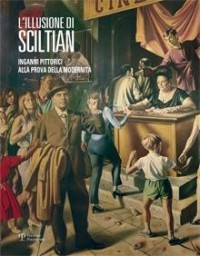Translation by Cole Fiala (Lorenzo de’ Medici)
The Gregorio Sciltian monographic exhibition at the Villa Bardini encompasses the artist’s entire oeuvre with more than 100 works.
Born in Russia, Sciltian moved to Italy in the 1920s where he advocated for traditional figurative art during an era in which the Avant Garde, Cubism, and abstraction monopolized the artistic world. To facilitate understanding, the public can benefit from a free docent available on each hour, for a tour of the same duration. Alternatively, the informative material found in each room, however offered only in Italian, is exhaustive.
The exhibition develops around three principle themes that characterize Sciltian’s paintings: illusion, often understood as a deception, which inspires the title of the exhibition, combined with the adherence to the traditional language and themes of painting, particularly from the seventeenth century, and finally, the critical rejection of avant-garde art. Curator Stefano Sbarbaro incorporates a thematic organization in seven distinct sections to better illustrate these elements.
A large painting, The Eternal Illusion, greets visitors in the first room on the first floor while introducing Sciltian’s artistic manner. Essentially, the work serves to represent the assortment of themes that characterize his philosophy. Beyond illusion, Sciltian favors iconography, like the Adoration of the Magi, which reveals a tendency to follow tradition.
Now on the second floor, the next room is consists of still-lives, a subject favored by artists during the 17th century. Perfectly attune to the theme of deception, this playful extent of trickery further proves artistic virtuosity. For example, Table of the Art Critic, 1940, which is dedicated to the Italian academic Roberto Longhi, emphasizes a play on paintings within a painting. The reflective lens thereby evokes a complex relationship between reality and fiction. This occurs again in the subsequent section, which is entirely dedicated to mirrored reflections, thus allowing the visitor to mentally project him or herself into the artwork.
Sciltian’s reputation for portraiture features predominantly in the following room. Famous commissions throughout his career include the renowned collector Galeazzo Ciano. Displayed adjacently, Antonio Donghi’sWomen on the Stairs provides evidence that the Russian master was on par with other major portrait artists of the 1920s. This claim also extends to the realm of theatrical arts with two portraits of the De Filippo brothers.
The central part of the exhibition surrounds a criticism of contemporary art that, according to Sciltian, abandons technical drawing and therefore defies tradition. In light of this, one of Sciltian’s most famous works, Osteria Bacco, 1936, appropriates the setting from Caravaggio’s Calling of St. Matthew while representing modernity through the realism that characterizes his art.
At the end of the exhibition it becomes clear that Sciltian’s art and philosophy reflect the epitaph inscribed on his tomb: “The only true and supreme aim of art has been, and will always be, to achieve the illusion of reality”.
L’illusione di Sciltian. Inganni pittorici alla prova della modernità
By Carolina Caverni (University of Florence)
Villa Bardini mette in mostra una monografica su Sciltian con più di un centinaio di opere che coprono tutta la carriera dell’artista.
Nato in Russia, si trasferì in Italia negli anni ’20 e fu un convinto sostenitore dell’arte figurativa tradizionale in anni in cui le avanguardie, il cubismo e l’astrattismo monopolizzavano il panorama artistico.
Il pubblico può usufruire ogni ora della guida che è gratuita e che accompagna per un visita che dura circa un ora. Il materiale informativo che si trova in ogni sala è comunque molto esaustivo, sebbene solo in italiano.
Tutta l’esposizione si sviluppa intorno a tre temi principali che caratterizzano la pittura di Sciltian; l’illusione, intesa spesso come inganno a cui si ispira il titolo della mostra, l’aderenza ad un linguaggio e a temi provenienti dalla pittura tradizionale, in particolare quella seicentesca, e il rifiuto nonché critica dell’arte delle avanguardie. Per meglio evidenziare questi elementi il criterio espositivo scelto dal curatore, Stefano Sbarbaro, è tematico e dunque le opere sono raccolte in sette sezioni distinte.
La grande pittura L’eterna illusione accoglie il visitatore nella prima sala al primo piano e rappresenta un po’ il manifesto dell’arte di Sciltian. L’opera introduce ai temi che caratterizzano la sua poetica, oltre all’illusione, l’iconografia, simile ad un’ adorazione dei magi, evidenzia quanto sia importante per l’artista il legame con la tradizione.
La sala successiva, una volta saliti al secondo piano, è dedicata alle nature morte, soggetto tipico del XVII secolo, che si adatta perfettamente al tema dell’inganno, che è continua finzione, elemento giocoso e prova di virtuosismo. In Tavolo del Critico d’arte, del 1940 dedicata a Roberto Longhi, il gioco dei quadri dentro al quadro e delle lenti che riflettono creano un complesso rapporto tra realtà e finzione.
La sessione successiva è tutta dedicata ai riflessi allo specchio, ed è lo stesso visitatore che può riflettersi in uno specchio al muro.
Sciltian, durante la sua carriera, ebbe molto successo come ritrattista dunque una sezione è dedicata ai suoi ritratti di personaggi anche molto famosi come ad esempio Galeazzo Ciano, suo grande apprezzatore e collezionista. Nella stessa stanza è esposto Donne per le scale di Donghi che mette in evidenza come l’artista russo fosse in linea con la ritrattistica monumentale degli anni 20.
La finzione passa anche attraverso il tema del teatro espresso nei due ritratti dei fratelli De Filippo.
La parte centrale della mostra è dedicata alla critica dell’artista verso le correnti coeve che hanno, secondo Sciltian, perso l’uso del disegno e dunque alla difesa della tradizione; Bacco in Osteria del 1936 è forse una delle sue opere più famose. Qui riprende l’impostazione di La chiamata di San Matteo del Caravaggio e rappresenta la modernità con il realismo che caratterizza la sua arte.
Alla fine del percorso la riflessione sull’arte e sulla poetica “Sciltiana” corrisponde con ciò che egli ha lasciato scritto sulla sua tomba: “L’unico vero e supremo scopo dell’arte della pittura è stato e sarà sempre quello di ottenere l’illusione della realtà”
